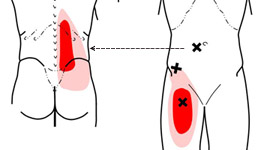This is a series on low back pain. If you missed the summary of causes, go back to Part 1.
For those of you who practice Pilates, the iliopsoas muscle should be familiar to you. It’s the deep hip flexor you use (or should be using) with teaser, rolling like a ball and any rollup or roll back exercises. In fact, this primary core muscle should be used in all your exercises whether you do Pilates or not. Dysfunction in the iliopsoas muscle causes pain in the lumbar portion of your low back.
Travell and Simons in Myofascial Pain and Dysfunction: The Trigger Point Manual list it as one of two muscles that that are “frequently responsible for a failed low back postsurgical syndrome.” It often develops pain in response to Trigger Points in other functionally related muscles like the quadratus lumborum, erector spinae, deep paraspinals, lower abdominals and glutes, all of which can cause low back pain.
 The iliacus portion of the iliopsoas attaches all along the inside of your hip, the psoas portion to all of your lumbar vertebrae and the disc spaces between them. Just from it’s location, you can understand how it causes low back pain.
The iliacus portion of the iliopsoas attaches all along the inside of your hip, the psoas portion to all of your lumbar vertebrae and the disc spaces between them. Just from it’s location, you can understand how it causes low back pain.
Primarily the iliopsoas is a hip flexor. In upright posture when it contracts (shortens) it lifts and separates the lumbar vertebrae, taking the pressure off the vertebral joints. Both parts of the muscle are active during any sitting or standing position and anytime there is flexion of the thigh at the hip.
The Trigger Points that refer from the psoas refer vertically up ea ch side of the spine. When both sides are involved, it can feel as if the pain is going across your back. Trigger Points can also feel like a gas pain or a menstrual cramp. In childbirth, pain from the iliopsoas is what causes back labor. With constipation, pressure from a hard bolus or straining can activate Trigger Points.
ch side of the spine. When both sides are involved, it can feel as if the pain is going across your back. Trigger Points can also feel like a gas pain or a menstrual cramp. In childbirth, pain from the iliopsoas is what causes back labor. With constipation, pressure from a hard bolus or straining can activate Trigger Points.
Activation of Trigger Points happens when a tight muscle is hyperflexed for prolonged periods, such as when crouching on the floor, sitting on a soft deep couch, driving with the knees higher than the hips or sleeping in a fetal postion. They also get activated by overloading the muscle in such activities as ballet dancing, too many sit-ups, catching oneself from a fall, and the forward force of a pregnant or otherwise large belly.
The previous posts have covered the major muscular causes of low back pain that I treat in my Neuromuscular Therapy practice near Boston. There are two more minor muscular causes and the ligaments to discuss.